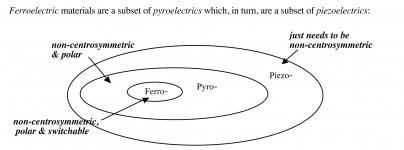It wasn't static, it was a distinct rubbing sound when the cables were moved or tapped, like the output of a mike or vibration sensor (which in essence it was).
Bingo! Now you can see the whole picture.
Indeed, some manufacturers make cable vibration sensors, putting PVDF as insulator, which has piezoelectric effect orders of magnitude stronger than PTFE.
Bingo! Now you can see the whole picture.
It's tribo. Not piezo.
And even PVDF, which has the correct symmetry to achieve piezo, must be poled in order for the effect to appear. Plain old PVDF insulation doesn't exhibit these effects, which is exactly what the physics predicts.
It's tribo. Not piezo.
And even PVDF, which has the correct symmetry to achieve piezo, must be poled in order for the effect to appear. Plain old PVDF insulation doesn't exhibit these effects, which is exactly what the physics predicts.
Yes and no, in that order. 😀
The electric polarization due to mechanical stress in a dielectric is given by
Pi = dijk σjk + μijkl ∂εjk/∂xl (*)
Where the flexoelectric coefficient, μijkl, is a fourth-rank polar tensor and dijk is the coefficient corresponding to the direct piezoelectric effect.
Crystal lattices lacking a center of symmetry can exhibit piezoelectricity.
There are four possible crystalline phases for PVDF, α, β, γ and δ.
In the α-phase, PVDF has the crystallographic point group symmetry 2/m, which it is centrosymmetric, then it cannot exhibit direct piezoelectric effect, however, it exhibit flexoelectric effect, i.e. polarization induced by the strain gradient, second term in (*)
In the β-phase, PVDF has the crystallographic point group symmetry mm2, which it is non-centrosymmetric, and then it exhibit direct piezoelectric effect, first term in (*); even more, into this phase PVDF is ferroelectric, and hence it is also pyroelectric.
The most conventional method for production of β-PVDF is uniaxial stretching of α-PVDF, or annealed above 80 ºC, poling is not always necessary.
Attachments
Last edited:
Here a reference to a triboelectric and a chart down the page . Patent EP2603687A1 - Dipole triboelectric injector nozzle - Google Patents
Look at paper and polystrene interesting .
http://www.google.com/patents/EP2603687A1?cl=en
Look at paper and polystrene interesting .
http://www.google.com/patents/EP2603687A1?cl=en
That table shows lead and aluminium on the -ve side
nickel, copper, brass, silver, gold, platinum are all on the +ve side.
Silver is closer to teflon than is copper. That indicates that copper/teflon has a higher triboelectric charge than silver/teflon.
Why are foamed styrene and polystyrene so far apart?
Why are the rubbers so far apart.
What alloys of aluminium is in their DUT?
Aluminium/silk aluminium/paper copper/hard rubber and silver acetate would seem to be combinations for least triboelectric effect.
nickel, copper, brass, silver, gold, platinum are all on the +ve side.
Silver is closer to teflon than is copper. That indicates that copper/teflon has a higher triboelectric charge than silver/teflon.
Why are foamed styrene and polystyrene so far apart?
Why are the rubbers so far apart.
What alloys of aluminium is in their DUT?
Aluminium/silk aluminium/paper copper/hard rubber and silver acetate would seem to be combinations for least triboelectric effect.
Last edited:
That table shows lead and aluminium on the -ve side
nickel, copper, brass, silver, gold, platinum are all on the +ve side.
Silver is closer to teflon than is copper. That indicates that copper/teflon has a higher triboelectric charge than silver/teflon.
Good point!
Another unfavourable combination would be Skin/Teflon as both are almost on opposite extremes in the triboelectric series.
- Status
- Not open for further replies.
- Home
- Member Areas
- The Lounge
- Audiophiler capacitors on ebay

